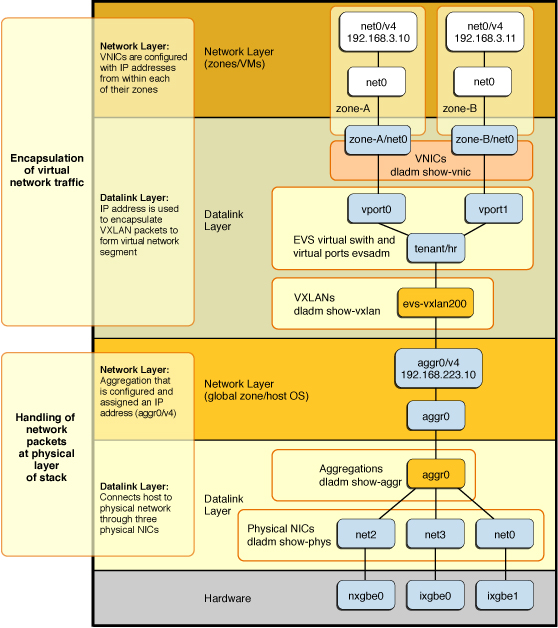Creating a Highly Available Virtual Network Stack for Cloud Environments
The following figure shows how you might combine multiple network virtualization features, for example, link aggregations, VNICs, VXLANs, and an EVS switch, to provide a highly available and integrated virtual network stack for cloud environments.
In this figure the datalink and network layers of the network protocol stack appear twice. This layering is the result of using VXLANs which provide virtual network segments that are encapsulated within IP packets. The datalink and network layers therefore appear twice in the resulting network stack: once to show the handling of packets at the physical layer and then again to show the encapsulated virtual network traffic within these layers of the stack.
The datalink layer that is shown at the lower level of the figure (just above the hardware layer) is used to connect the host to the physical network through three physical NICs, which are aggregated to provide high availability. The resulting aggregation is configured at the network layer and assigned an IP address (aggr0/v4). The same IP address is then used to encapsulate VXLAN packets which form a virtual network segment. In Oracle Solaris, VXLANs are configured through datalinks and then used through VNICs. These VNICs are then configured with IP addresses from within their zones, as depicted in the datalink and network layers that are shown in the top portion of the figure.
Figure 1-3 Combining Aggregations With VXLANs, VNICs, and an EVS Switch

The figure represents the following configuration:
-
Starting from the hardware layer, multiple physical NICs (net0, net2, and net3) are aggregated to form a highly available link aggregation called aggr0.
-
The aggregation is then configured with an IP address, aggr0/v4 (192.168.223.10).
-
An EVS virtual switch tenant/hr is created on top of the IP interface aggr0. In this figure, EVS is configured to use a VXLAN.
The new vxlan0 datalink is connected to a virtual L2 network that overlays the IP network.
-
Assuming that EVS assigned the virtual switch a VXLAN ID of 200, EVS automatically creates a VXLAN datalink called evs-vxlan200, which is associated with the tenant/hr virtual switch.
-
The EVS switch has two virtual ports (vport0 and vport1), which are connected to two VNICs that are used by two zones. The VNICs appear in the zone as datalinks named net0 and are visible from the global zone as zone-A/net0 and zone-B/net0.
For some examples of how you would deploy these features, see Chapter 2, Network Configuration Scenarios.